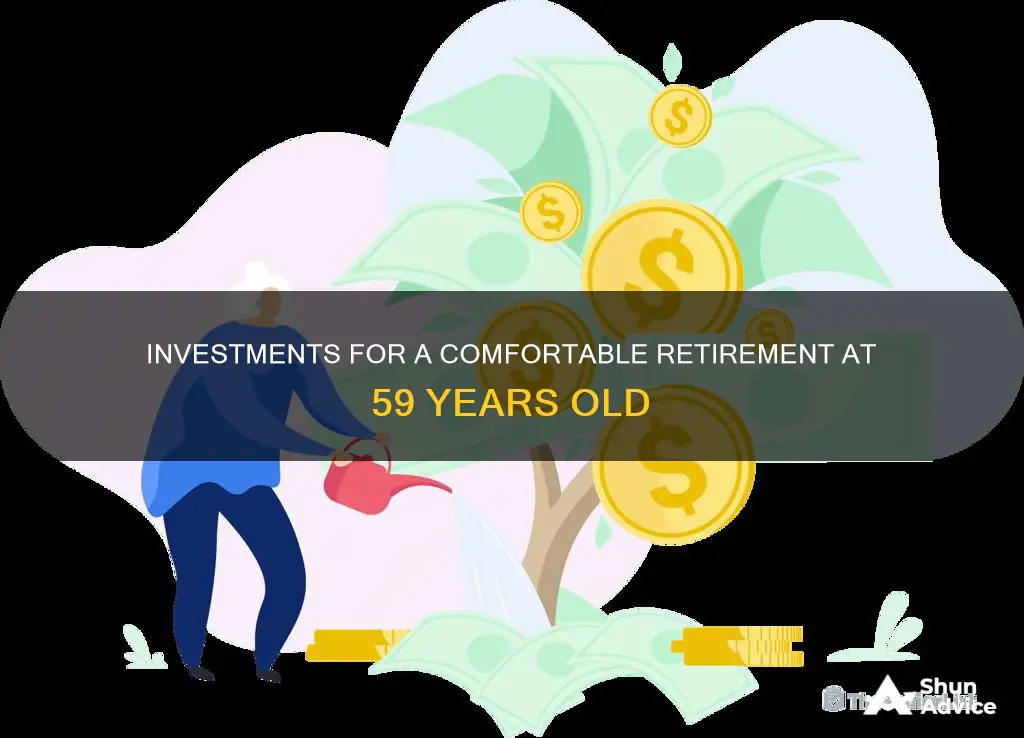
Retirement is a significant life milestone, and it's never too early to start planning for it financially. For those approaching retirement age, such as those aged 59, it's crucial to ensure your investments are in order to maintain financial stability and security. This includes taking advantage of tax-efficient accounts, such as 401(k) plans and Individual Retirement Accounts (IRAs), as well as considering the right mix of assets, including stocks, bonds, and other investment vehicles. Here are some key considerations for those looking to make investments at 59 years old.
| Characteristics | Values |
|---|---|
| Retirement savings | 11 times your ending salary |
| Savings target | 15% of annual income |
| Retirement contribution limits | Increase with "catch-up" contributions at age 50 |
| Taxable account | Save in addition to retirement accounts |
| Stocks | Maintain healthy exposure |
| Bonds | Consider adding a meaningful allocation |
| Emergency fund | Cover 3-6 months of expenses |
| Retirement readiness | Assess your situation |
| Tax diversification | Broaden with multiple types of accounts |
| Asset allocation | Review and adjust |
| Retirement income | Include Social Security benefits |
What You'll Learn

Fund your 401(k) to the max
If you're 59 years old and your workplace offers a 401(k) plan, funding it to the maximum amount is a great way to boost your retirement savings. Here's why:
Tax Advantages
Funding a 401(k) plan offers significant tax advantages. Firstly, with non-Roth accounts, you can defer paying taxes on your income until you withdraw it during retirement. This is beneficial if you're in a higher marginal tax bracket now than you will be during retirement, as you'll face a smaller tax bill later.
On the other hand, if your employer offers a Roth 401(k), you'll pay taxes on the income now, but your withdrawals in retirement will be tax-free. This option may be preferable if you expect to be in a higher tax bracket in the future.
Higher Savings Balance
The more you contribute to your 401(k), the larger your savings balance will be. By maximising your contributions, you can build a substantial amount of savings over time, making it easier to reach your retirement goals.
Compound Growth
Maximising your 401(k) contributions can accelerate compound growth. For example, assuming an 8% annual growth rate, contributing the maximum of $22,500 per year for 10 years would result in savings of about $326,000. In comparison, contributing half that amount over the same period would result in savings of $163,000, a significant difference.
Employer Match
If your employer offers a match on your contributions, maximising your 401(k) ensures you take full advantage of this benefit, which is essentially free money. For example, a common type of match is 50% of your contributions up to 6% of your salary. To get the full match in this case, you would need to contribute at least 6% of your salary.
Peace of Mind
By funding your 401(k) to the maximum, you can have peace of mind knowing you're doing everything you can to secure your financial future. This can help you retire with dignity and leave a lasting legacy for your family.
Investment vs Financial Management: What's the Core Difference?
You may want to see also

Diversify your portfolio
Diversifying your portfolio is a crucial aspect of investment, especially as you approach retirement age. Diversification can help protect your portfolio during market downturns and smooth out returns. Here are some ways to diversify your portfolio as a 59-year-old:
Asset Allocation
Allocate your assets across different classes such as stocks, bonds, cash and cash equivalents, commodities, real estate, futures, and derivatives. The allocation should be age-appropriate and reflect your risk tolerance. While stocks provide growth potential, bonds offer more stability. A conservative portfolio for older investors might consist of 70-75% bonds, 15-20% stocks, and 5-15% cash or cash equivalents.
Diversify Within Asset Classes
Within the stocks portion of your portfolio, ensure you have exposure to large, small, and mid-size companies, as well as established and emerging international markets, and real estate. For bonds, allocate your investments across short-, mid-, and long-term U.S. and international bonds.
Low-Risk Options
Consider low-risk investments such as Treasury bonds, Certificates of Deposit (CDs), municipal bonds, high-yield savings accounts, and investment-grade corporate bonds. These options can provide stability and tax benefits.
Tax Diversification
Think about diversifying your investments from a tax perspective. While traditional IRAs offer tax benefits on contributions, Roth IRAs provide tax-free withdrawals in retirement. If eligible, consider contributing to a Roth IRA or, if your employer offers it, a Roth 401(k). This will give you more flexibility in terms of tax treatment when you withdraw funds in the future.
Target-Date Funds and Robo-Advisors
If you prefer a more hands-off approach, consider target-date funds or robo-advisors. Target-date funds automatically adjust their asset allocation based on your planned retirement year. Robo-advisors create and manage a portfolio based on your goals and risk tolerance. However, be mindful of any fees associated with these options, as they can eat into your returns.
Remember, diversification is a powerful tool to manage risk and smooth out returns. By diversifying your portfolio across asset classes, within asset classes, and from a tax perspective, you can help protect your investments and maximise your retirement savings.
Building a Perfect Investment Portfolio: Strategies for Success
You may want to see also

Consider a Roth IRA
A Roth individual retirement account (Roth IRA) can be a good source of tax-free income in retirement. If you're 59 years old, you may be at or close to your peak earning years, and you might be starting to think more seriously about retirement and whether you'll have enough money set aside.
With a Roth IRA, you can withdraw your contributions (but not their earnings) at any time without incurring taxes or penalties. This means that a portion of the money in your Roth account will always be immediately available to you if you need it. For example, if a child needs money for tuition, you can withdraw from your Roth IRA without penalties. If a child doesn't need it, then you can keep the money for retirement.
In addition, Roth IRAs are not subject to required minimum distributions (RMDs) during your lifetime, unlike traditional IRAs, from which you must generally begin withdrawals when you reach age 73 if you were born between 1951 and 1959, or 75 if you were born in 1960 or later. Thus, with a Roth IRA, if you don't need the money in retirement, you can let it continue to compound and leave it to your heirs someday. They will, however, have to withdraw it eventually—typically within five or 10 years, depending on their relationship with you.
To get the full tax benefit from a Roth IRA, you'll need to follow some rules. To withdraw any of your account's earnings tax-free, you must have had a Roth IRA open for at least five years. Also, you must be at least 59 and a half years old or face an additional 10% early withdrawal penalty.
However, there are several exceptions to the early withdrawal penalty. For example, it is waived if you become disabled, regardless of your age at the time. You can also withdraw up to $10,000 (one time only) to buy, build, or rebuild a first home for yourself, a child, or a grandchild.
If you would like to open a new Roth IRA, you'll need to be within the income limits. In 2024, for example, married couples who filed a joint tax return could make a full Roth IRA contribution if their modified adjusted gross income (MAGI) was less than $228,000. If their MAGI was between $228,000 and $240,000, they could make a reduced contribution. If their MAGI exceeded $240,000, they were not eligible to contribute.
The maximum Roth IRA contribution for 2024 is $8,000 if you're 50 or older, or $7,000 if you're younger. That's per person; couples can double the amount if they both have IRAs.
To get around the income limits, some taxpayers use a two-step strategy that has come to be known as a backdoor Roth IRA:
- Step one: You contribute money to a traditional IRA, which has no income limits on eligibility, but your income can affect how much of your contribution is tax-deductible.
- Step two: You convert the traditional IRA into a Roth IRA. You will have to pay income tax on the money that you convert, but you would have paid tax anyway if you had been allowed to contribute to a Roth IRA to begin with.
Backdoor Roths have their critics, who see them as circumventing Congress's intentions in setting income limits. There have been attempts to curtail their use, but the strategy remains legal.
Converting a traditional IRA into a Roth isn't just a tax dodge for the wealthy. Anyone with a traditional IRA can roll over all or part of it into a Roth. There are no limits on the amount of money that you can convert, but you will have to pay income tax on it. The question to ask yourself is whether it makes more sense in your situation to convert and pay the taxes now (in return for tax-free income later) or just keep the money in your traditional IRA and worry about the taxes later.
One consideration is whether you expect to be in a lower tax bracket after you retire than you are today. In that case, waiting to convert could make sense. Another consideration is whether today's tax rates will remain in place 10, 20, or more years from now. No one knows, but if tax rates rise substantially, then converting sooner rather than later could be a smart move.
Smart Investing: 7 Lakh Rupees in India
You may want to see also

Know your income sources
When you're approaching retirement, it's important to know your income sources and how much you can expect to receive. Here are some key points to consider:
Traditional Pensions
If you have a defined-benefit pension plan through your current or previous employer, you should receive an individual benefit statement at least once every three years. You can also request a copy from the plan administrator annually. This statement will outline the benefits you've earned and when they become vested, meaning they belong to you. Understanding how your pension benefits are calculated is crucial. Many plans use formulas based on salary and years of service, so staying in the job longer could result in higher benefits.
Social Security Benefits
Once you've contributed to Social Security for ten years or more, you can get an estimate of your future monthly benefits using the Social Security Retirement Estimator. Your benefits will be based on your 35 highest years of earnings, so they may increase if you continue working. The age at which you start collecting Social Security benefits will also impact the amount you receive. You can opt to begin receiving benefits as early as age 62, but they will be permanently reduced compared to waiting until your full retirement age, which is 67 for anyone born after 1960. If you delay receiving benefits until age 70, you'll receive the maximum amount.
Retirement Savings Plans
If you have retirement savings plans such as a 401(k) or IRA, understanding the distribution rules is essential. While you can make penalty-free withdrawals from these accounts after age 59½, it's generally advisable to leave the funds untouched for as long as possible to maximize their growth. However, don't forget about required minimum distributions, which must begin at age 73 or 75, depending on your birth year.
Income from Investments
Income from investments and other assets, such as stocks, bonds, and real estate, can be a significant source of income for older adults. In 2022, over two-thirds of adults 65 and older received income from these types of assets. This type of income can provide a valuable supplement to your retirement savings and Social Security benefits.
Work Earnings
Even after reaching retirement age, some individuals choose to continue working and earning an income. In 2022, one out of five adults over 65 received income from earnings. This could include part-time or freelance work, depending on your preferences and needs.
By carefully considering these income sources and planning accordingly, you can make more informed decisions about your investments and retirement timeline. It's always a good idea to seek professional financial advice to ensure you're making the most of your income and savings during this important stage of your life.
Valuing Equity Growth Investments: Strategies for Success
You may want to see also

Save in a taxable account
If you're approaching retirement, it's important to ensure your portfolio is in good health. One way to do this is by saving in a taxable account.
Firstly, it's important to understand what a taxable account is. This is a type of investment account that does not offer any special tax benefits. This means that any gains or dividends accrued in the account are taxable in the year they are received. However, despite the lack of tax advantages, taxable accounts can be a great way to save for retirement, especially if you have already maxed out your contributions to tax-advantaged retirement accounts.
- Tax implications: As mentioned, taxable accounts do not offer any special tax benefits. This means that you will need to pay taxes on any gains or dividends received in the account. It's important to factor this into your overall tax strategy to avoid being caught off guard by a large tax bill.
- Investment choices: When saving in a taxable account, you have a wide range of investment choices available to you. This includes stocks, bonds, mutual funds, exchange-traded funds (ETFs), and more. It's important to carefully consider your investment choices and ensure they align with your risk tolerance, time horizon, and financial goals.
- Diversification: Diversification is important in any investment portfolio, and taxable accounts are no exception. Diversifying your investments across different asset classes and sectors can help reduce risk and improve the long-term performance of your portfolio.
- Tax-loss harvesting: One advantage of taxable accounts is the ability to use a strategy called tax-loss harvesting. This involves selling investments that have lost value and using the losses to offset taxable gains elsewhere in your portfolio. This can help reduce your overall tax bill and improve the performance of your portfolio.
- Long-term perspective: When saving in a taxable account, it's important to take a long-term perspective. This type of account is typically best suited for long-term goals, such as retirement, as it allows your investments to grow and compound over time.
- Fees and expenses: When investing in a taxable account, be mindful of fees and expenses, as these can eat into your returns. Compare the fees charged by different brokers and investment providers to find the most cost-effective option for your needs.
In conclusion, saving in a taxable account can be a great way to boost your retirement savings, especially if you have already maxed out contributions to tax-advantaged accounts. By carefully considering your investment choices, practicing diversification, and staying mindful of the tax implications, you can make the most of this savings vehicle and improve your overall financial outlook for retirement.
Savings Strategies: Maximizing Output from Your Investments
You may want to see also
Frequently asked questions
There are a few different types of investment accounts that may be suitable for someone your age. These include a 401(k), IRA (Individual Retirement Account), or a taxable account. A 401(k) is a tax-advantaged retirement account offered by many employers, and you can contribute up to 23,500 in 2025 if you are under 50, or 30,500 if you are 50 or older. An IRA has a lower contribution limit of 7,000 in 2024 and 2025, or 8,000 if you are 50 or older, but withdrawals are tax-free in retirement. A taxable account, as the name suggests, is taxed, but it can provide flexibility for different financial goals.
At 59, you may want to start moving some of your investments from more aggressive stocks or funds to more stable, lower-earning funds like bonds and money market funds. Stocks should still play an important role in your portfolio, but you can consider adding a meaningful allocation of bonds to reduce risk.
According to T. Rowe Price, by age 50, an individual should ideally have saved six times their salary. This increases to seven times their salary by age 55. However, this may vary depending on your financial goals and circumstances.







